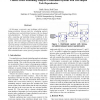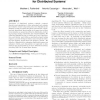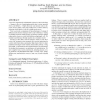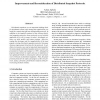DATE
2005
IEEE
15 years 17 days ago
2005
IEEE
In this paper we present a new technique which exploits timing-correlation between tasks for scheduling analysis in multiprocessor and distributed systems with tree-shaped task-de...
AINA
2005
IEEE
15 years 17 days ago
2005
IEEE
In this paper, we consider a distributed system that consists of a group of teams of worker robots that rely on physical robot messengers for the communication between the teams. ...
WPES
2006
ACM
15 years 27 days ago
2006
ACM
Connections in distributed systems, such as social networks, online communities or peer-to-peer networks, form complex graphs. These graphs are of interest to scientists in field...
SIGSOFT
2006
ACM
15 years 27 days ago
2006
ACM
Developers of distributed systems routinely construct discrete-event simulations to help understand and evaluate the behavior of inter-component protocols. Simulations are abstrac...
SIGCOMM
2006
ACM
15 years 27 days ago
2006
ACM
A pervasive requirement of distributed systems is to deal with churn — change in the set of participating nodes due to joins, graceful leaves, and failures. A high churn rate ca...
ACMSE
2006
ACM
15 years 28 days ago
2006
ACM
The design of large-scale, distributed, performance-sensitive systems presents numerous challenges due to their networkcentric nature and stringent quality of service (QoS) requir...
SRDS
2006
IEEE
15 years 29 days ago
2006
IEEE
Today’s large-scale distributed systems consist of collections of nodes that have highly variable availability — a phenomenon sometimes called churn. This availability variati...
SRDS
2006
IEEE
15 years 29 days ago
2006
IEEE
Distributed snapshots are an important building block for distributed systems, and, among other applications, are useful for constructing efficient checkpointing protocols. In ad...
SKG
2006
IEEE
15 years 29 days ago
2006
IEEE
Abstract. Global distributed systems must be standards-based to allow interoperability between all of their components. While this guarantees interoperability, it often causes loca...
ICPP
2006
IEEE
15 years 1 months ago
2006
IEEE
Recently, Bloom filters have been widely used in distributed systems where they are replicated to process distributed queries. Bloom filter replicas become stale in a dynamic en...




